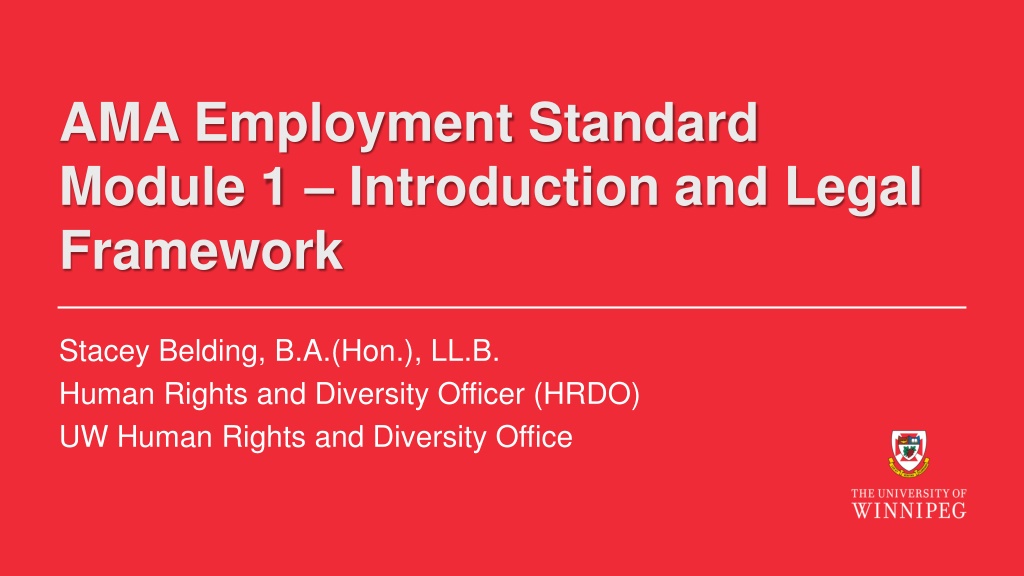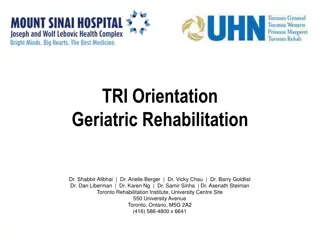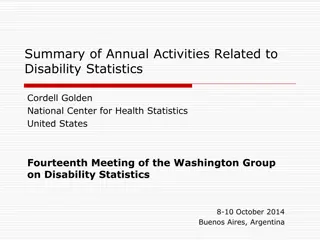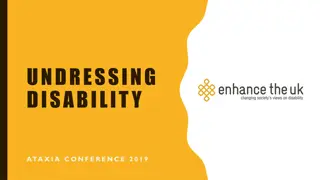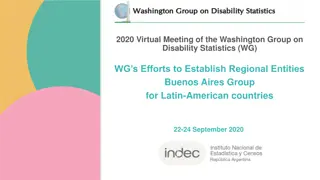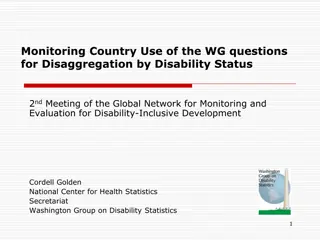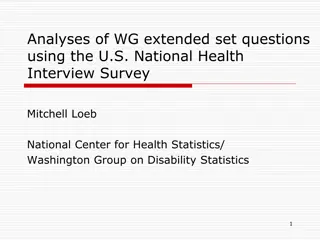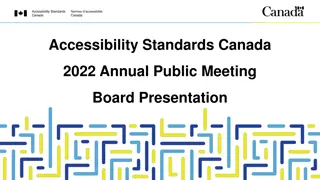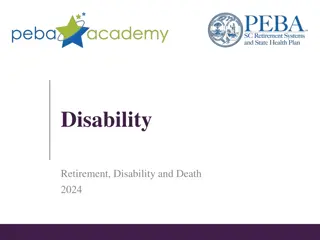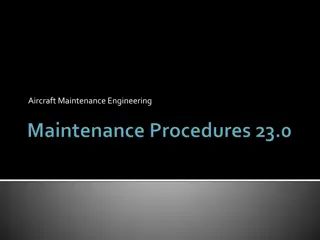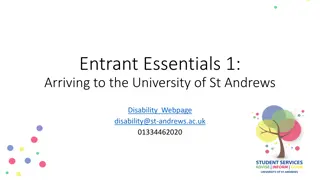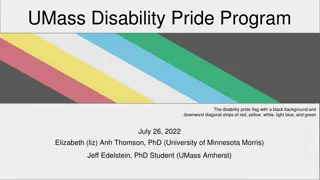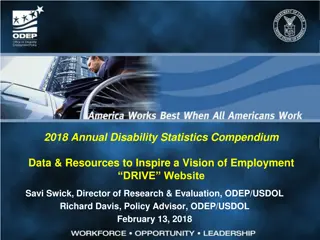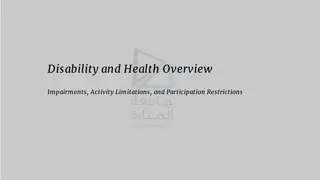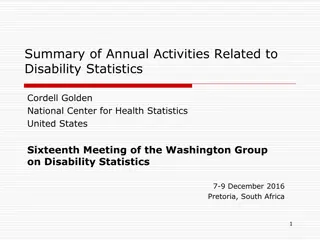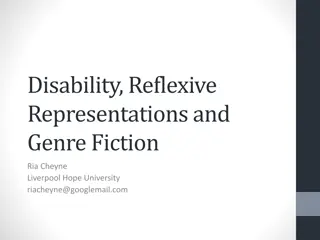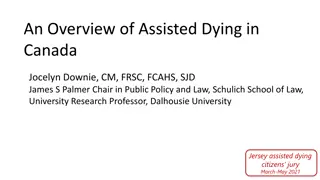Understanding Disability in Canada: A Comprehensive Overview
Gain a deep understanding of disability in Canada through Module 1 of the Employment Standard training at the University of Winnipeg. Explore legal frameworks, statistics, and societal biases to foster a more inclusive environment for individuals with disabilities in the workplace.
Download Presentation

Please find below an Image/Link to download the presentation.
The content on the website is provided AS IS for your information and personal use only. It may not be sold, licensed, or shared on other websites without obtaining consent from the author. Download presentation by click this link. If you encounter any issues during the download, it is possible that the publisher has removed the file from their server.
E N D
Presentation Transcript
AMA Employment Standard Module 1 Introduction and Legal Framework Stacey Belding, B.A.(Hon.), LL.B. Human Rights and Diversity Officer (HRDO) UW Human Rights and Diversity Office
AGENDA Module 1: Introduction and Legal Framework Purpose of the Training Overview of Disability in Canada Legal Framework The Accessibility for Manitobans Act and related Standards, and The Human Rights Code and related legal principles
Module 1: Introduction In compliance with the Employment Standard, this training is mandatory for all University of Winnipeg faculty and employees with responsibility for recruitment, selection, training, supervising, managing, coordinating, promoting, redeploying, or terminating employees, and those involved in developing employment policies and practices. This training will introduce the key elements of the Second Standard and consists of three (3) modules.
Module 1: Introduction The online training will benefit our employees by providing important insight on how to provide reasonable accommodation during the recruitment process and in employment. At the completion of the course, a record will be generated for audit purposes for verification of institutional compliance. Thank you for your contribution toward building a barrier-free community at the University of Winnipeg.
Module 1: Overview of Disability in Canada An estimated one in five Canadians aged 15 years and over had one or more disabilities that limited them in their daily activities, according to findings from the 2017 Canadian Survey on Disability (CSD). 13% of youths aged 15 to 24 years had one or more disabilities, with mental health-related disabilities being the most prevalent type of disability for this age group (60%) 20% of working age adults (25 to 64 years) have a disability 38% of seniors aged 65 and over have a disability Women (24%) are more likely to have a disability than men (20%), across all age groups
Module 1: Overview of Disability in Canada Many disabilities are invisible, such as mental health conditions and learning disabilities. 10% of Canadians have invisible disabilities. Despite the prevalence of disability, implicit biases about persons with disabilities are pervasive. One study found that [p]reference for people without disability compared to people with disabilities was amongst the strongest across the social group domains . Significantly, 76 percent of respondents showed an implicit preference for people without disabilities.
Module 1: Overview of Disability in Canada o Persons with disabilities aged 25-64 were less likely to be employed (59%) than those without disabilities (80%), have lower incomes on average, and are more likely to live in poverty. o Yet 90% of people with disabilities did as well or better at their jobs than co-workers without disabilities, 86% rated average or better in attendance, and staff retention was 72% higher among persons with disabilities. o When accommodations are necessary for people with disabilities in the workforce, 20% cost nothing and 50% cost less than $500. o Almost half of all complaints to the Manitoba Human Rights Commission are disability-related. Disability is the most common ground involved in reasonable accommodation complaints across Canada.
Module 1: Legal Framework The Accessibility for Manitobans Act o Customer service standard (regulation) o Employment standard (regulation) The Human Rights Code (Manitoba) Related human rights principles
The Accessibility for Manitobans Act In December 2013, the Manitoba government passed The Accessibility for Manitobans Act ( the AMA ) Purpose: To achieve accessibility for all Manitobans by preventing and removing barriers that disable people with respect to employment, accommodation, built environment, and delivery and receipt of goods, services and information A barrier is anything that interacts with a person s disability in a way that may hinder that person s full and effective participation in society on an equal basis. o Barriers can be physical, architectural, informational, attitudinal, and technological, or based on a policy or practice. o i.e.: areas inaccessible by elevator, shelving too high, website or documents unreadable by screen reader, certain attendance policies, sound-only alarms, etc.
The Accessibility for Manitobans Act The AMA states that regard must be had for the following principles in helping to achieve accessibility: Access: Persons should have barrier-free access to places, events and other functions that are generally available in the community; Equality: Persons should have barrier-free access to those things that will give them equality of opportunity and outcome; Universal design: Access should be provided in a manner that does not establish or perpetuate differences based on a person's disability; Systemic responsibility: The responsibility to prevent and remove barriers rests with the person or organization that is responsible for establishing or perpetuating the barrier.
The Accessibility for Manitobans Act The AMA also mandates every public sector body to prepare an accessibility plan every two (2) years that addresses the identification, prevention and removal of barriers that disable people in the policies, programs, practices and services of the public sector body. The University of Winnipeg Accessibility Plan can be found online: https://www.uwinnipeg.ca/respect/docs/uwinnipeg-accessibility-plan.pdf (contact the Human Rights & Diversity Office to obtain a copy in an accessible format) All faculty and staff are encouraged to review the Accessibility Plan and consider what actions can be taken to increase accessibility in their departments.
AMA Accessibility Standards (Regulations) Accessibility Standards (regulations under the AMA) focus on 5 key areas of daily living: 1. The Customer Service accessibility standard - November 2015 2. The Employment accessibility standard - April 2019 3. The Information and Communications accessibility standard 4. The Design of Public Spaces accessibility standard 5. The Transportation accessibility standard
Customer Service Standard Addresses training and communication focused on respectful and barrier- free customer service. Training related to the AMA Customer Service Standard is provided to UW employees via an online module: https://www.uwinnipeg.ca/respect/ama- online-training.html
Key Customer Service Standard requirements Provide access to accessible formats and academic/workplace accommodations; Allow assistive devices, such as wheelchairs or walkers; Welcome support people and service animals; Ensure accessibility in built environment is maintained as intended (ramps, wide aisles, removal of clutter); Let customers know when accessible features and services are not available by posting a Notice of Service Disruption form, along with other channels such as social media; Invite customers to provide feedback; and Ensure all public events are accessible.
Employment Accessibility Standard - Overview Addresses practices related to employee recruitment, hiring, employment Reasonable accommodation required at various stages of employment including: recruitment, offer of employment, on the job, and return to work Training regarding the AMA and Employment Standard, The Human Rights Code, and how to provide reasonable accommodation during recruitment and employment is required for all employees with supervisory and recruitment duties, and those involved in creating employment policies. Emergency response - create emergency response information (plans) to help employees with disabilities stay safe during emergencies; and ask employees who require assistance during an emergency for permission to share information with individuals who agree to help.
Employment Standard Reasonable Accommodation Required Under both the Employment Standard and The Human Rights Code, an employer is legally required to establish and implement measures, policies and practices respecting employment to reasonably accommodate employees and applicants who are or may be disabled by one or more barriers in the workplace. Reasonable accommodation allows a person to access the materials or activities used in the assessment or selection process, to perform their employment responsibilities, or to access the benefits available to them by virtue of their employment. Examples of reasonable accommodation can include providing documents in large print or a different format, welcoming or providing access to a service animal or interpreter, having an interview in an accessible location, and considering the impact of barriers on performance, attendance, etc.
Employment Standard Reasonable Accommodation Required Reasonable accommodation in recruitment processes When conducting recruitment, an employer must inform potential applicants that reasonable accommodation is available upon request with respect to the assessment or selection process, as well as materials or activities used in the assessment or selection process. At UW, we have an active offer of accommodation in our employment advertising. If an accommodation is requested, the applicant must be consulted and a reasonable accommodation provided unless it would result in an undue hardship to the employer/university. When offering employment to a person, the applicant must be informed of the employer's measures, policies and practices for accommodating employees disabled by one or more barriers in the workplace.
Employment Standard Reasonable Accommodation Required Must consider impact of barriers in recruitment, training, and career advancement The process for recruiting, selecting, training, promoting, redeploying, or performance managing an employee must take into account the following: that employees may be temporarily or permanently disabled by one or more barriers in the workplace; an employee's individualized accommodation plan, if any; and that the accommodation provided for a particular employee, if any, may not fully address a barrier that disables the employee.
Employment Standard Reasonable Accommodation Required Workplace Accommodation Policy elements details about how an employee can request an accommodation, and that both the employee and possible accommodations will be assessed on an individualized basis, that an evaluation conducted by a health care or other professional to assist with the accommodation may be arranged at the employer s expense, that the employee can request assistance from their bargaining agent or person knowledgeable in the area of workplace accommodations in the development of the plan, the frequency with which the plan will be reviewed and updated (which can be done sooner upon the employee s request), that the plan must be provided to the employee in an accessible format upon request, the circumstances in which the request for a plan may be denied and that written reasons must be provided, and that the employee s personal information and personal health information will be appropriately protected at all times and the steps taken to protect it.
Employment Standard Reasonable Accommodation Required Return to Work Policy A return to work policy that includes details about the accommodation process followed when an employee who has been absent due to a disability is also required (details included in Workplace Accommodation Policy) Individualized Accommodation Plans Individualized accommodation plans must be provided on request to employees who are temporarily or permanently disabled by barriers including any required accessible formats and communication supports, emergency response information, and details of any other reasonable accommodation including its manner and timing. The plan must be reviewed and updated as needed when the workplace is modified or relocated, employee responsibilities change, or other changes impact the accommodation required.
Employment Standard Reasonable Accommodation Required Employee cooperation An employee is required to cooperate in the establishment and creation of the accommodation plan including by: providing necessary information including medical or other expert reports, comply with and perform their work in accordance with the plan, provide feedback to the employer including advising if the plan needs to be modified or is no longer required, and participate in any necessary evaluation to determine their accommodation needs.
Employment Standard Reasonable Accommodation Communication of information On request of the employee, an employer must consult with the employee to identify accessible formats or needed communication supports, and ensure that the accessible formats or supports are used when providing information to the employee. Keep employees informed Each employee must be provided with information about the employer s accommodation measures, policies, and practices, and any changes to them. Privacy Obligations In addition to existing FIPPA and PHIA requirements, the University must protect the privacy and confidentiality of the personal information and personal health information provided by employees who require accommodation, and may only collect, use, and disclose information as required by law, unless disclosure is consented to by the employee.
The Human Rights Code - overview The Human Rights Code (the Code ) prohibits discrimination and harassment based on the protected characteristics outlined in the Code, including physical or mental disability or related characteristics or circumstances, including reliance on a service animal, a wheelchair, or any other remedial appliance or device. The Code also prohibits reprisal (retaliation) against someone on the grounds that they have or may file a complaint or make a disclosure under the Code, or otherwise participate in a related process. The Manitoba Human Rights Commission is the government body responsible for enforcement of the Code. If a complaint is filed and not resolved in mediation, it is investigated by the Commission. After investigation, a recommendation is made to the MHRC Board of Commissioners as to breach. If a recommendation that a breach occurred is accepted by the Board, it is referred to a public adjudication that can result in significant monetary damages and other relief.
The Human Rights Code - overview The Code applies to employment, services (Universities), housing, contracts, and signs/statements. Employment is broadly defined - actual or potential, full-time or part time, permanent, seasonal or casual, and paid or unpaid; or work performed under contract with the worker or another person/company. The Code also applies to pre-employment inquiries, which includes the recruitment and selection process, and any aspect of employment including: the opportunity to participate (or to continue to participate) in employment; the customs, practices and conditions of employment; training, advancement, promotion, and seniority; remuneration (salary, vacation pay, and benefits); and any other benefit, term or condition of employment.
The Human Rights Code discrimination Treating a person or group differently without reasonable cause to their detriment, on the basis of an actual or presumed characteristic (protected characteristic) rather than on the basis of personal merit. (differential treatment). o Someone s protected characteristic cannot be a factor - even if not the sole factor - in an adverse decision o Cannot ask questions about someone s protected characteristics o Special programs are permitted, i.e.: targeted hires, employment equity programs. Self-declarations must be voluntary. Failing to make reasonable accommodation for the special needs of an individual or group if those needs are based on a protected characteristic, i.e.: introducing measures to remove barriers such as providing an interpreter, an accessible washroom, time off to attend medical appointments, considering impact of barriers on performance, etc.
Reasonable accommodation under the Code The obligation to take special measures to accommodate someone who has a special need based on a disability or another protected characteristic The purpose of accommodation is to remove barriers to full participation in society, to help level the playing field Accommodation must be provided to the point of undue hardship, namely significant safety concerns or an unsustainable financial burden. Reasonable accommodation requires an adequate process, as well as substantive accommodation. Need not be preferred accommodation and employee must cooperate. o Person seeking accommodation must provide reasonable medical evidence substantiating or clarifying the need, answer questions and make suggestions, and generally cooperate in the process.
Reasonable accommodation under the Code How is the duty to accommodate triggered? Usually the employee must identify the need for accommodation, which then puts onus on employer to engage in process If an employer knows the person may need an accommodation, or they ought to know, they have a duty to inquire even if not requested. Often arises in cases of mental health or substance use disorder, due to stigma or denial of those conditions. When ought the employer to know (and thus inquire)? Very poor job performance, behaving in a very unusual or uncharacteristic manner, awareness of certain circumstances (recent return from medical leave, seeing a psychologist, drinking heavily on lunch breaks), etc.
Reasonable accommodation under the Code What is undue hardship? Generally, undue hardship is based on cost or health and safety. Not employee morale, or inconvenience. The vast majority of accommodations are not expensive nor are they unsafe or difficult to implement. Objective evidence is required (financial statements, invoices, etc.) Cost is considered at institutional/business level, not unit (i.e.: if accommodation budget exceeded, look elsewhere); both the employer and employee are required to consider outside sources of funding, such as government assistance/programs, non-profit funders, etc. The nature of the risk: what could happen that would be harmful? The severity of the risk: how serious would the harm be if it occurred? The probability of the risk: how likely is it that the potential harm will actually occur? Is it a real risk, or merely hypothetical or speculative? Could it occur often? The scope of the risk: who will be affected if it occurs? Health and safety risks - consider:
End of Module 1 Stacey Belding, HRDO (204) 988-7508 s.belding@uwinnipeg.ca
Module 2 Accessibility in Recruitment
AGENDA Module 2: Reasonable accommodation in recruitment Recap of the duty to accommodate Recap of Employment Standard requirements Best practices for accessibility in recruitment
Accessibility in Recruitment duty to accommodate An employer is legally required to establish and implement measures, policies and practices respecting employment to reasonably accommodate employees and applicants who are or may be disabled by one or more barriers. Reasonable accommodations in the recruitment process could include providing the interview in an accessible location, allowing additional time to do tests or other evaluations, arranging an interpreter, providing questions in an accessible format, welcoming a service animal or support person in the interview, considering equivalent experience, not penalizing applicants whose work history is interrupted for medical reasons, etc.
Accessibility in Recruitment ES requirements Include an active offer in all postings: the employer must inform prospective applicants of the availability of reasonable accommodations in respect of the application and selection process, and the materials or activities used in the assessment or selection process. (s. 5(1)) Cooperative process: employer must consult with the applicant to determine the reasonable accommodations (s. 5(2)) Provide reasonable accommodations during the assessment or selection process. (s. 5(2)) Inform new employees: when employment is offered, the candidate must be informed of the employer s measures, policies, and practices for accommodation (s. 6)
Accessibility in Recruitment Best practices Design the position and selection criteria to ensure that they relate to the ability to perform the job: o Each criterion must be based on bona fide position requirements and should not create unnecessary barriers to applicants Ask yourself: is a specific type or length of work record a valid test of a candidate s ability to meet the requirements of the position? Are there equivalencies? Is this essential, or desired/an asset? Requirements like having a driver s licence can exclude persons with a visual impairment when really the criteria is having transportation. o Selection criteria should be clear, yet flexible, in order to adapt to non-traditional career paths. Consider equivalent education and experience, and the value of diverse experiences.
Accessibility in Recruitment Best practices Consider a targeted hiring process - hiring committees should consider whether there is an underrepresentation in their department and, if so, consider a targeted hiring process. Designated Hire The posting will specify that the successful candidate must be from a specific equity group(s) as identified in the posting. If there are no qualified candidates from the identified equity group(s), this will result in a failed search and a new search process must be commenced. Preference Hire The posting will indicate that preference will be given to candidate(s) from a specific equity group(s) identified in the posting. If there are no qualified candidates from the identified equity group(s), the hiring department may still proceed with hiring a qualified candidate.
Accessibility in Recruitment Best practices Consider advertising in non-traditional sources and broaden search ask HRDO o Advertise widely social media, via your colleagues including those in other departments, promoting the position via professional associations including those of underrepresented groups o Conduct other targeted outreach, i.e.. contact organizations who help persons disabled by barriers find employment Ensure job postings are accessible o Consider how content is experienced by those with visual impairments use a larger or adjustable font size, avoid quirky fonts, use larger contrast, and use Word not Pdf documents. o Consider how content is experienced by those with dyslexia sans serif fonts are better, use bold not italics o Include active offer that alternative formats are available upon request.
Accessibility in Recruitment Best practices Provide reasonable accommodations o If accommodation requested, refer the candidate to your HRC who will work with candidate to determine accommodations o Keep information shared with you confidential o Only deny accommodation where undue hardship and after consultation with the HRDO safety, financial o Committees must not allow for any requested accommodation to negatively influence their view of a candidate during the assessment process. Hiring committees o Where possible, try to ensure diversity on the hiring committee o Request unconscious bias training from the Human Rights & Diversity Office
Accessibility in Recruitment Best practices Screening and evaluation o Be mindful that the best-qualified candidates may not have the most years of experience or greatest number of accomplishments, and that a candidate s barriers may not always have been accommodated. o Consider equivalent and volunteer experience, life experience, and benefits of diversity o Consider impact of bias on job experience, references, employment interruptions o Consider impact of intersectionality o Provide reasonable accommodation as needed for any screening processes for example, accessible formats, oral vs. written evaluation (or vice versa), use of interpreter, quiet room, additional time to write test
Accessibility in Recruitment Best practices Interview process Consider accessibility of interview location Before the interview, consider how much you can let people know in advance without compromising the integrity of the process: How long the interview should take, what the process will be, how many people involved Provide copies of questions in advance, if possible (even 15-30 minutes) Unless an applicant requests otherwise, speak at a normal place and volume Review the position description together before each interview to ground everyone in the task at hand and provide written copies of the questions during the interview. Welcome service animals and support persons Do not pet or interact with service animals. Speak to the candidate, not their support person.
Accessibility in Recruitment Best practices Offering employment o Inform new employee of availability of reasonable accommodation and refer them to the Workplace Accommodation Policy and related policies (see list at the end of the presentation). o If needed, refer the employee to the Employee Health & Wellness Specialist to determine reasonable accommodation, including any required emergency response plans
End of Module 2 Stacey Belding, HRDO (204) 988-7508 s.belding@uwinnipeg.ca
Module 3 Accessibility in Employment
AGENDA Module 3: Reasonable accommodation in employment Recap of the duty to accommodate Overview of three key processes Reasonable accommodation process Emergency response process Other Employment Standard requirements Tips for creating an inclusive culture Best practices for communication
Accessibility in Employment duty to accommodate An employer is legally required to establish and implement measures, policies and practices respecting employment to reasonably accommodate employees and applicants who are or may be disabled by one or more barriers. Reasonable accommodations during employment could include allowing the employee time off for frequent medical appointments, providing a screen reader, allowing for additional breaks, sending reminders about tasks, locating the workspace near a washroom, rebundling or changing duties, installing automatic door openers, extending deadlines for tasks, making an emergency response plan, providing a quiet workspace, or considering the impact of the medical condition on performance or attendance issues, etc. Reasonable accommodation is an individualized process, subject to change
Accessibility in Employment 3 key processes Individualized accommodation plan: on request of an employee experiencing barriers, the employer must work with the employee to develop individualized plan detailing accommodation measures including accessible formats/communication supports Workplace emergency plan: if an employee may face additional risks or barriers during an emergency, the employer must work with the employee to develop an individualized emergency plan Return to work: where needed following a disability-related absence, the employer must work with employee to develop an individualized accommodation plan and/or workplace emergency plan
Accessibility in Employment Accommodation Process Step 1 Implement accommodation Employee makes request for accommodation, returns to work following disability related absence, or employer is aware of circumstances that may require accommodation, such as symptoms of a mental health concern Refer employee to Employee Health & Wellness Specialist and maintain confidentiality Employee Health & Wellness Specialist consults with employee to determine needs, obtain suggestions for accommodation including any emergency response and accessible format/communication supports. Medical required to support request. o Employee may request assistance from their union representative or a person knowledgeable in the area of workplace accommodation. Manager may also be involved in process. o Employee is required to cooperate in process provide medical and participate in evaluation of what reasonable accommodation is required, accept reasonable solutions, and perform work in accordance with plan.
Accessibility in Employment Accommodation Process Step 2 Monitor, review and update Employee is required to provide feedback on plan, and continue to cooperate and communicate if needs change Manager/Employee Health & Wellness Specialist to required to review and update plan when: o Feedback from employee suggests changes needed or circumstances have changed, or the employee specifically requests a review o Employee s workspace is modified or relocated o Employee s responsibilities change o Manager becomes aware of other changes that impact accommodation required o Annually when performance reviewed or as otherwise agreed
Accessibility in Employment Emergency Response Employee requests assistance during emergency refer to Employee Health and Wellness Specialist or online form (see list of resources at end) EHWS works with employee to develop plan: o Collect necessary information and request consent to share plan with those assigned to help o Involve manager, HRDO, Health & Safety, etc. as needed o Consider emergency alert methods - alarm, co-worker, pager, other o Consider assistance required - staff, transfer instructions, needed equipment o Determine evacuation routes and procedure o Advise designated emergency support staff fire marshals, co-worker(s), or manager who may provide assistance, i.e.: notify employee if alarm sounded, stay with employee, etc. Review and update plan when workspace moved, modified, or other changes occur that would affect emergency response
Accessibility in Employment Other requirements Performance management The employer must ensure that any performance management process takes into consideration that the employee may be disabled by barriers, their individualized accommodation plan (if any), and that the accommodations provided may not fully address the barrier(s) (s. 8 ES) o Performance management process includes any process used by the employer to manage the work; plan, monitor and review the employee s work objectives and overall contribution to the workplace (s. 8(2) ES) Reinforces existing obligation under human rights law to consider the impact of barriers on performance Managers should consult with HRC during this process, and HRDO as needed
Accessibility in Employment Other requirements Career development training and internal advancement The process for recruiting, selecting, training, promoting, or redeploying an employee must take into account that the employee may be disabled by barriers, their individualized accommodation plan (if any), and that the accommodations provided may not fully address the barrier(s) (s. 9 ES) Reinforces existing human rights obligations that employees with disabilities should not be denied recruitment, advancement, or training opportunities available to others. Disability cannot be a factor in decision to withhold a benefit or opportunity. Duty to accommodate applies during training and other processes themselves, i.e.: providing accessible formats or communication supports during training
